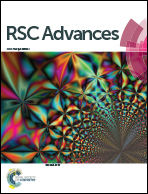Green synthesis of BiOBr modified Bi2O2CO3 nanocomposites with enhanced visible-responsive photocatalytic properties†
Abstract
BiOBr/Bi2O2CO3 nanocomposites with mesh-like structures were simply synthesized by a green solid-state chemical reaction route with no extra template or surfactant. The as-synthesized nanocomposites have an altered thickness with the different composite ratio and exhibited excellent visible light photocatalytic activity for the degradation of dyes. The optimum photocatalytic activity of BiOBr/Bi2O2CO3 with a molar percentage of 60% was almost 25 times higher than Bi2O2CO3 towards degradation of RhB by visible-light. The enhanced photocatalytic activity could be attributed to the extended absorption in the visible light range and the formation of p–n heterojunctions between p-type BiOBr and n-type Bi2O2CO3 which promoted the photogenerated electron–hole separation. Radical scavenger experiments indicated that ·O2− and h+ played a major role during the RhB degradation process. The photocatalytic mechanism during the degradation process was also proposed.


 Please wait while we load your content...
Please wait while we load your content...